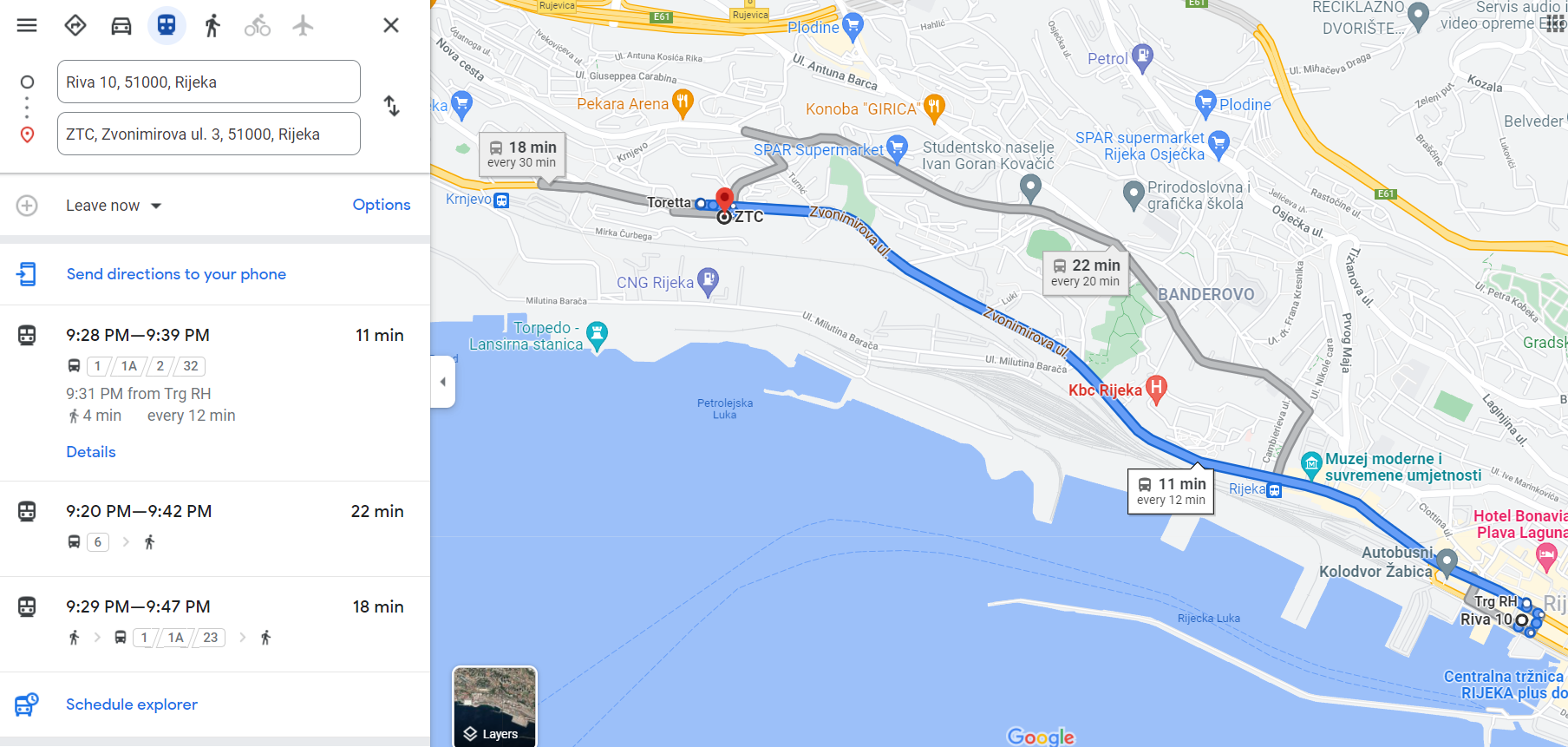Remediation of Sovjak Pit in Viškovo to Begin by End of Year
ZAGREB, 2 Feb 2022 - The remediation of the Sovjak pit near Rijeka, worth about HRK 390 million, is planned to start by the end of the year. It is estimated there is currently about 152,000 cubic meters of waste in the pit, making this one of the largest and most complex environmental protection projects in the country.
The Sovjak pit is a natural karst sinkhole that has been used since 1949 for the uncontrolled and improper disposal of hazardous waste.
It is estimated that about 250,000 cubic meters of various waste were disposed of in the pit by the 1990s. Examples include acid sludge, a waste material generated as a by-product during the production of lubricants, motor oils and asphalt, waste asphalt from coke ovens, waste oils and fuel oils from shipyards, residues from storage tanks for oil, petroleum products and others.
At a press conference on Wednesday, the director of the Environmental Protection and Energy Efficiency Fund, Siniša Kukić, underscored the complexity of the project preparation process, during which three remediation models had been proposed. The final model was selected through consultation with the citizens of Viškovo.
"The project is large and complex not only due to high costs, but also due to works taking place in the immediate vicinity of houses", he said.
Kukić also added that the contractors were required to meet the highest standards of environmental protection, adding that the safety of the residents was their priority.
Permanently remove threat to environment and residents
Sanja Udović, the head of the municipality of Viškovo, expressed satisfaction that after many years, the remediation of the pit would start.
"The project will not be easy nor simple, but it will permanently remove the threat to the environment and the consequences the residents have been feeling for decades," she said.
The State Secretary at the Ministry of the Economy and Sustainable Development, Mile Horvat, said this was a key moment for the residents of Viškovo because new green space was being created.
Primorje-Gorski Kotar County Prefect Zlatko Komadina said that the problem of the Sovjak pit was a result of decades-long irresponsible behaviour.
"The price of remediation is high, but nothing is more expensive than the health of residents", he said.
The remediation project was presented by Maja Feketić, the head of the Sector for EU Funds at the Environmental Protection and Energy Efficiency Fund, saying that the contractors selected in the public call were joint bidders GK Group from Varaždin, Slovenian EKOMO, and IVICOM Consulting from Zagreb.
Deadline 54 months
The deadline for the completion of works is 54 months. 85% of the investment has been secured from EU funds, while the rest will be covered by the Fund.
The remediation is expected to begin by the end of 2022.
For more, check out our dedicated lifestyle section.
Found Some Coloured Pebbles on a Beach? They Could be Part of a Scientific Study
February 2, 2022 - By studying gravel beach erosion and recovery, the Beachex project aims to come up with effective methods of beach nourishment and ensure a sustainable increase in beach capacity in Croatia
We all love a relaxing long walk on the beach, perhaps even more so in winter when beaches grow quiet with the crowds gone. And it’s not a strange habit to pick up a few shells washed ashore, a lovely pebble or some sea glass. What to do if you happen to come across some rather strangely colored pebbles? Best leave them where you found them, as they might be part of a scientific study.
Enter the Beachex project, a part of which is currently being conducted on Ploče beach in Rijeka. As reported by Novi list, a sign has been put up on the beach to warn passersby not to (re)move the smart pebbles, as researchers are tracking their movement in order to determine morphodynamics of artificial beaches.
The project in question is run by the Faculty of Civil Engineering of the University of Zagreb in collaboration with the Lancaster Environment Centre at Lancaster University, and in short, it aims to study beach erosion.
What inspired the project? As explained on the Beachex project website, the pressure on gravel beaches in Croatia is twofold. On one side, there’s the ever-expanding tourism industry, generating a need to increase beach capacity by beach nourishment to accommodate the growing number of beachgoers. At present, beach nourishment in Croatia isn't regulated by law, and is thus often conducted with artificial materials that are unsuitable for the purpose and harmful for the ecosystem.
On the other end, there’s also the increased storm activity caused by climate change, also leaving its mark on beaches.
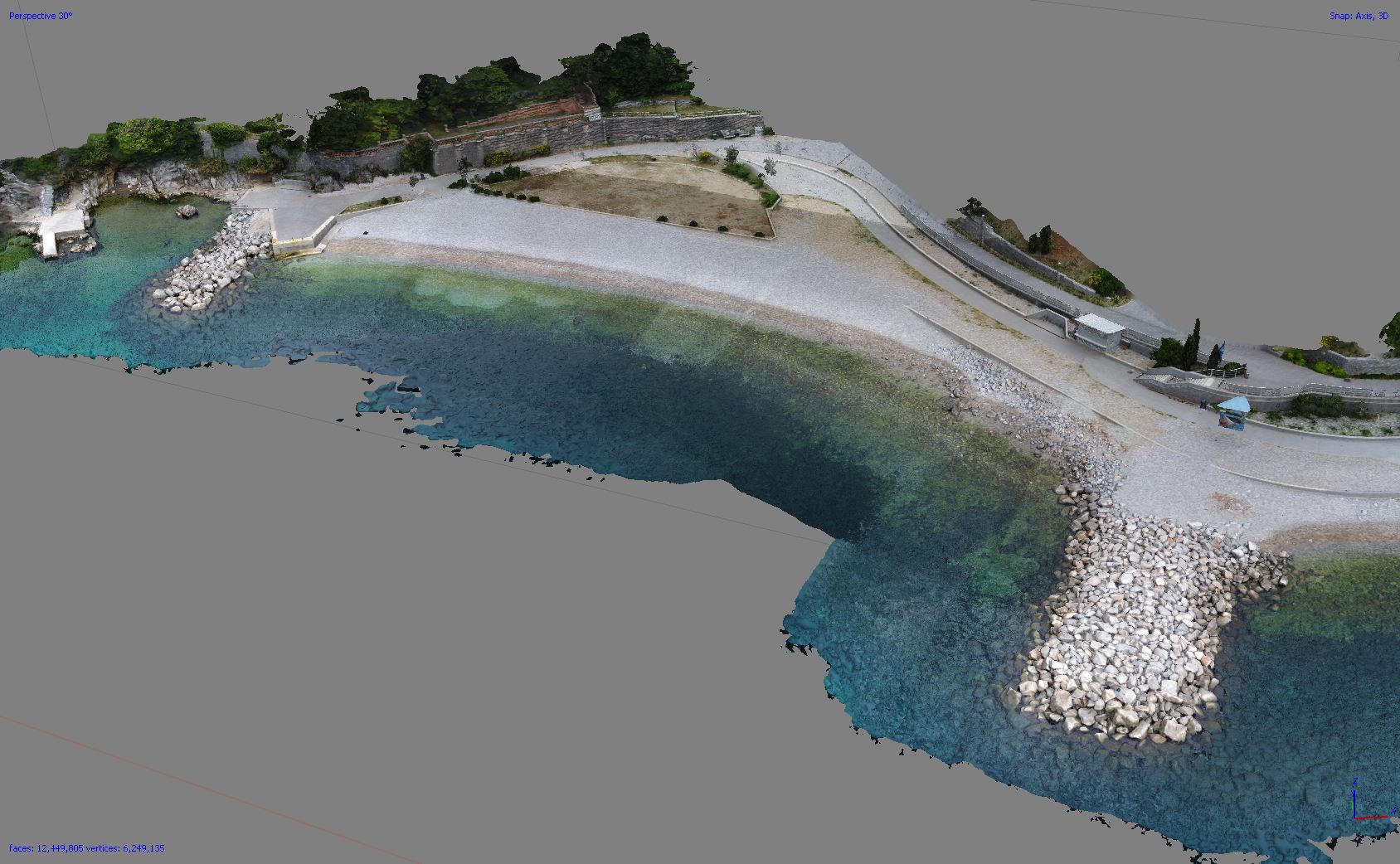
Ploce beach in Rijeka / Image source: grad.hr/beachex
‘The Beachex project aims to explore the mechanisms of gravel beach erosion and recovery to provide technical support for long-term beach nourishment in order to achieve a sustainable increase in beach capacity while reducing the influence of climate change’, states the project website.
Apart from the smart pebbles, measurements are collected on Ploče beach using video monitoring and an oceanographic buoy combined with geodesy measurement.
Tracking beach morphodynamics, however, is just one of the project’s goals. Researchers are also building a database of nourished beaches in Croatia and aim to educate the public about beach erosion through workshops in Rijeka and Split. The impact of beach nourishment on marine life is being studied through dive surveys on beaches in several coastal towns.
All the data collected as part of the project will also help scientists predict the impact of climate change in regards to beach sustainability, so that preventative action can be taken to reduce the influence of extreme natural events on beaches, as well as tourism at large.
All in all, if you see a pebble coloured bright red, yellow, or any other colour that kind of looks out of place on a gravel beach, just leave it - best not to intervene in those morphodynamics.
Find out more about the Beachex project here.
HNL Round 21 Recap: Belupo Shocks Osijek, Dinamo Tops Rijeka, Hajduk Wins in Šibenik
January 31, 2022 - The 21st round of the Croatian First League was held from January 28 to 30, 2022. The Croatian First League thus returned from a long winter break, with the first part of the season ending on December 19, 2021. Here is our HNL round 21 recap.
Istria 1961 v. Gorica (2:1)
Istra and Gorica opened the 21st round and the second part of the season on Friday, January 28, 2022, in front of 262 fans.
Jovicic put Gorica in the early lead for 0:1 in the 6th minute. Perkovic scored the equalizer to open the second half for 1:1 in the 58th minute. Drena Beljo put Istra in the lead in the 74th minute and ultimately gave them the 2:1 win.
Istra is currently in 9th place with 21 points, while Gorica is in 5th with 29.
Osijek v. Slaven Belupo (1:2)
Osijek and Belupo met at City Garden Stadium on Saturday, January 29, 2022, in front of 2,072 fans.
While the first half went without goals, Belupo's Zvonarek put them ahead in the 49th minute for 0:1. Bozic scored for 0:2 Belupo in the 68th. Former Hajduk player Caktas scored in his Osijek debut for 1:2 in the 74th minute, the final score.
Osijek is currently in 3rd place with 40 points, while Belupo is in 8th with 22.
Šibenik v. Hajduk (1:3)
Šibenik and Hajduk met on Saturday, January 29, 2022, at Šubićevac stadium in front of 1,156 fans.
Hajduk took the lead thanks to a Livaja penalty in the 15th minute. Curic equalized 10 minutes later for 1:1, before a second Hajduk penalty was awarded before the half - Livaja nailed it for 1:2. Hajduk's final goal was a screamer from Krovinovic, who scored in the 68th minute for 1:3.
Šibenik is currently in 7th place with 22 points, while Hajduk is in 4th with 38 points (and one game in hand).
Lokomotiva v. Hr. Dragovoljac (2:1)
Lokomotiva and Dragovoljac met in Zagreb on Sunday, January 30, 2022.
Hozda put Dragovoljac in the lead in the 22nd minute for 0:1, before Dabro equalized before the half for 1:1. Ibrahim opened the second half with a quick goal in the 46th minute for the final 2:1. Dragovoljac's Basic was sent off in the 87th minute for a double yellow.
Lokomotiva is currently in 6th place with 27 points, while Dragovoljac is in 10th place with 7.
Dinamo v. Rijeka (2:0)
Dinamo and Rijeka closed out the 21st round on Sunday, January 30, 2022, at Maksimmir Stadium.
Sutalo scored for the Dinamo lead in the 22nd minute (1:0). Orsic made it 2:0 in the 42nd minute, the final score.
Dinamo is currently in 1st place with 43 points (and a game in hand), while Rijeka is in 3rd with 40.
You can see the HNL standings HERE.
To read more about sport in Croatia, follow TCN’s dedicated page.
Panoramic Wheel Set Up in Rijeka, Promptly Mocked by Locals
January 30, 2022 - The new attraction has stirred up controversy due to an unfortunate choice of location
A panoramic wheel was set up in Rijeka earlier this week, at a location near the waterfront in the city centre. The wheel is 22 metres tall and has 18 cabins that fit 4-5 people each.
It’s the same ferris wheel that was previously installed in Varaždin by the company Fest d.o.o. as part of the Advent programme last year in December. The attraction has now moved to Rijeka for the carnival season, and will remain there until the end of February.
‘The wheel is quite attractiv and completely new, it arrived in Croatia from a world-famous factory in Italy late last year’, said Anita Tuček of Fest d.o.o. for Novi list.
The ferris wheel had stirred up controversy among the local population before it was even made operational, mostly due to the unfortunate choice of location. Namely, it was set up in a small square flanked by two buildings, one of the same height, the other taller than the wheel itself. The view from the top thus leaves a lot to be desired, especially in a city that has quite a few nice viewpoints as it is.
As far as panoramas go, this one is a bit narrow, and it’s been immensely fun keeping up with the public opinion on the subject. Numerous online comments rightly point out there are bars and restaurants in the vicinity that offer a better view, one of them located in a building right next to the wheel. (If you take a ride, at least you can see the daily menu through the window without having to climb a few flights of stairs, says one comment.)
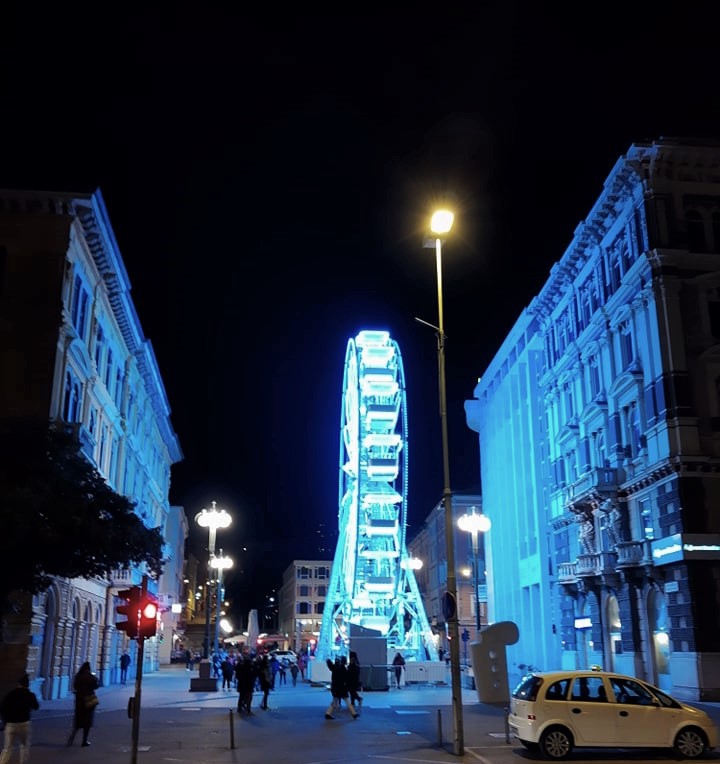
Some have suggested that the passenger terminal in the nearby ferry port would have been a much better location for a panoramic wheel and would actually offer a new and attractive view of the city; others have said the same for the Delta parking lot, also in the city centre. That being said, it’s believed that the current location was chosen as the safest one in case of strong wind, a common occurrence in Rijeka which would likely prove fatal (for a ferris wheel, at least) in any other location that isn't partially shielded.
Many have also criticised the price, seen as steep at 45 kuna for a ride that lasts several minutes and offers a spectacular view of someone’s second-floor apartment. Tickets for kids aged 5-12 cost 35 kuna, and children under 5 years of age get to ride the wheel free of charge. There are also family tickets, priced at 140 kuna for a party of four.
Judging by the comments on local media's socials, some locals wouldn’t mind the cost if the panoramic wheel was set up at a better location. Others have jokingly said it’s better to have three pints at a bar for the price of the ferris wheel ride if you so badly want to have your head spinning.
And then there are those who fervently defend the panoramic ride, saying they’re happy to see a new attraction in town even if it’s not exactly a match for the London Eye. It’s the infamous Croatian mentality, they said - complaining there’s nothing to do in this town and then viciously attacking any attempt to offer something new and exciting. There’s some truth to that; also, with the carnival parade rescheduled for the summer, us Rijeka locals were in dire need of another subject of debate.
I'm siding with those who consider it a cool concept, but poorly placed - it would have been nice to see the town from a new perspective. This way, the wheel looks more like a kids' ride in an amusement park, and in a way, it's what makes it seem like a fun prospect nonetheless. It might be worth paying 45 kuna to have a good laugh.
It remains to be seen if the panoramic wheel will turn out to be a popular attraction in spite of the majority making fun of its location. Those interested can hop on anytime between 3pm and 9pm on workdays, or from 10am to to 9pm on weekends.
Rijeka Mayor Says Welcomes Any Move Leading to Decentralising Governance
ZAGREB, 22 Jan 2022 - The mayor of Rijeka, Social Democrat Marko Filipović, said on Saturday he welcomed any move towards decentralising governance but that he could not comment in greater detail on a proposal by Split Mayor Ivica Puljak for Split, Rijeka and Osijek to be given powers that the capital of Zagreb has.
Asked by Hina if he had discussed the topic with Puljak, Filipović said that he had not and therefore could not comment on it in greater detail but that he definitely welcomed any move leading to the critically necessary decentralisation.
The Rijeka mayor said that any decentralisation of powers had to be accompanied by financial decentralisation to facilitate the exercise of those powers.
Split Mayor Ivica Puljak (Centre party) announced on Friday that the city administration would ask the national parliament to pass a law to enable that city, as well as Rijeka and Osijek, to govern their entire territory.
He explained that that way, those three cities and possibly other cities "would be able to... make order in their territory wherever they wanted, avoiding red tape at the higher levels of government."
Puljak said he had discussed the matter with PM Andrej Plenković during his recent visit to Split, which was their first official meeting after the May 2021 local election, when Puljak was elected mayor.
Puljak said Split-Dalmatia County head Blaženko Boban (HDZ), who also attended the meeting, did not agree with his initiative.
For more, check out our dedicated politics section.
From Vials to Valium, Rijeka's JGL Pharmacy Museum Is a Delight
January 23, 2022 - Visiting the JGL Pharmacy Museum in Rijeka, a modern cabinet of curiosities where vintage tablet-making machines meet the latest technology and elegant design
Tucked away in the Old town in Rijeka is one of the city’s most unique collections to discover. Explore the hissstory of pharmacy, says the snake on the wall, nudging us towards the entrance. Fear not - the snake is here as a symbol of health, rejuvenation and medicine, the mascot of the JGL Pharmacy Museum.
The specialised museum presents the history of pharmacy in a global context with a focus on Croatia and Rijeka in particular. Opened in October 2020, it was founded by the Croatian pharmaceutical company Jadran-Galenski laboratorij d.d. (hence the JGL in the name), whose vision is for the museum to become a reference institution in research of pharmacy history and a tourist attraction in Rijeka.
Based on what we’ve seen, it’s definitely an attraction. Albeit small, the permanent exhibit is a modern cabinet of curiosities where vintage tablet-making machines and hundreds of tiny vials and test tubes meet the latest technology and elegant design.
A wonderful garden of health (hortus sanitatis) featuring medicinal and other herbs covers the wall and guides you to the entrance:
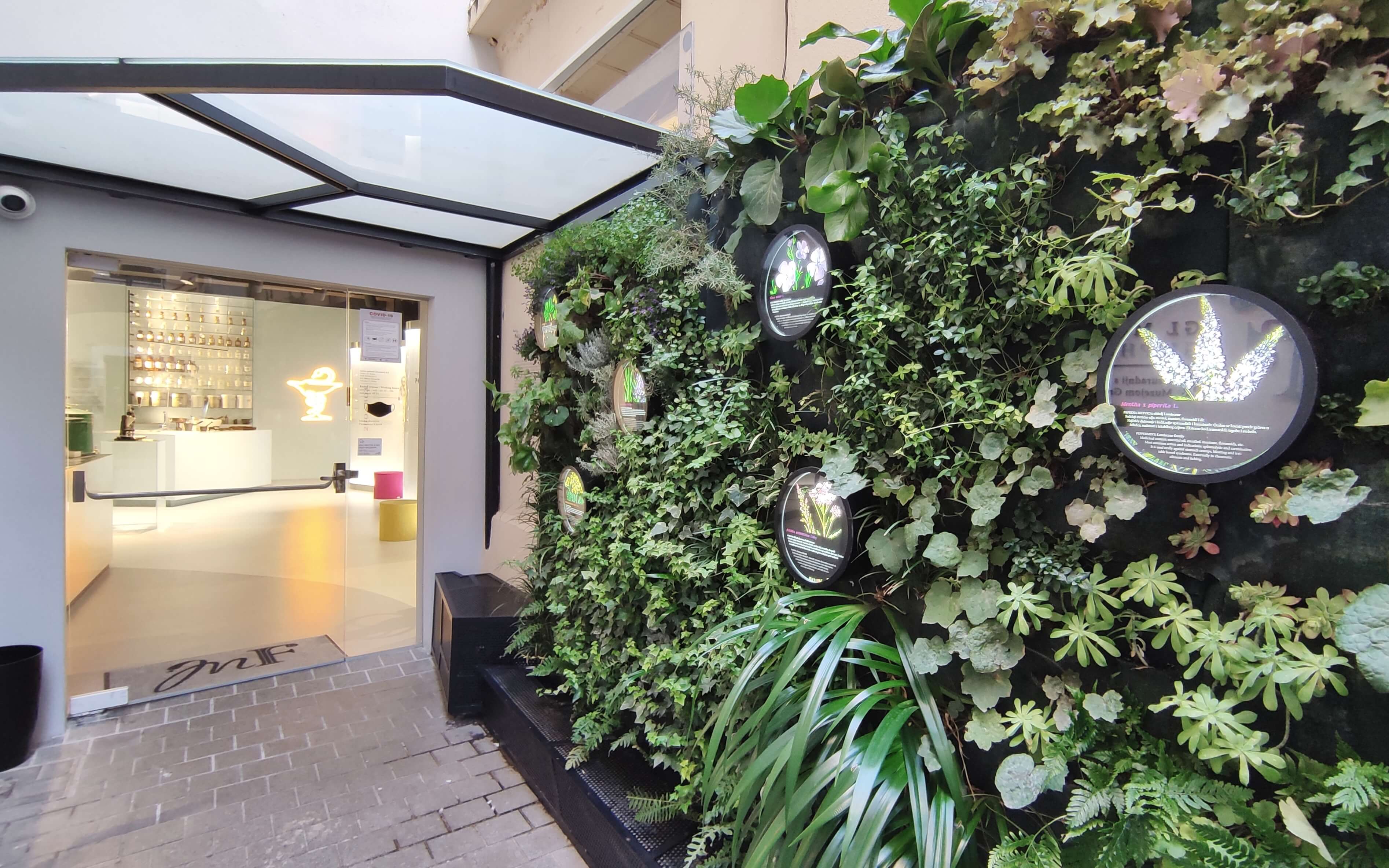
Inside, a sleek glass timeline snakes through the exhibition space and comes to life through AR, with distinguished individuals from the history of pharmacy telling their stories and teaching us a few interesting facts along the way.
You’d be perfectly fine just checking out the exhibits as the display is engaging enough as it is, but the AR points significantly add to the experience as they expand on the info presented on the panels, making the historical personalities more entertaining and lifelike - this will likely be a deciding factor if you’re visiting with kids. The AR guide is available in Croatian and English - pick up your tablet when purchasing tickets at the entrance.

Here are a few things we learned to spark your curiosity:
- The inventor of diazepam was born in Opatija, Croatia! Chemist Leo Henryk Sternbach invented the medicine first marketed as Valium in the early 1960s, after he’d moved to the US where he worked for Hoffmann-La Roche. By the end of the 60s, Valium became the top-selling medicine in the US. Sternbach soon retired but didn’t rest on his laurels, instead going on to work at the lab and mentor students for another 30 years.
- The Dalmatian town of Trogir was home to the oldest pharmacy in Croatia; the establishment was specifically mentioned as a pharmacy in historical records as early as 1271!
- The first monastic pharmacy soon followed: the Friars Minor pharmacy in the Franciscan monastery in Dubrovnik was founded in 1317. The Croatian Ministry of Culture placed the Dubrovnik pharmacy on the list of intangible cultural heritage in 2019.
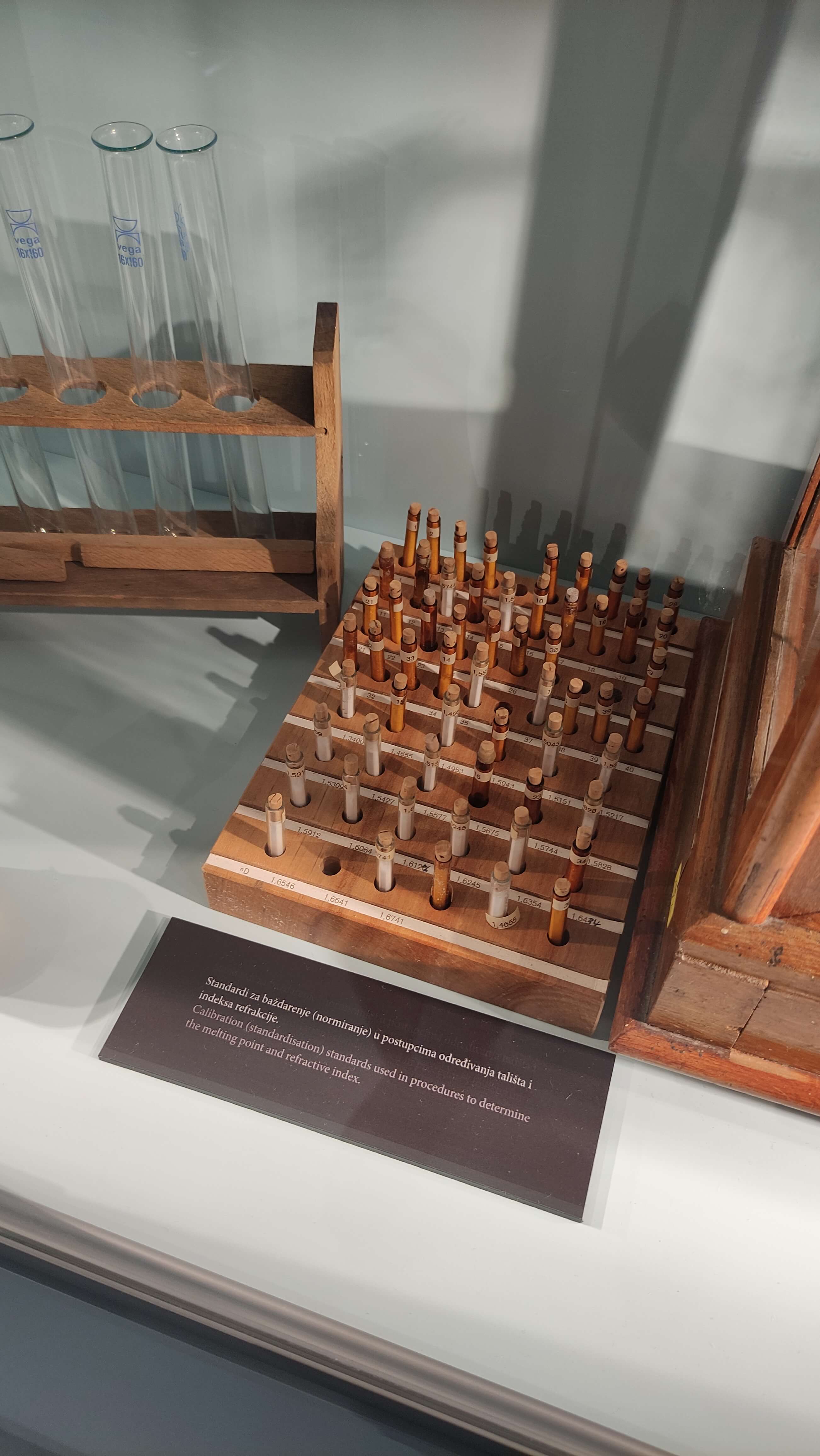
- Another nod to Dubrovnik as the first place in the world to introduce mandatory quarantine. In 1377, the Great Council of Dubrovnik passed a legislation that had all arrivals from areas ravaged by plague spend 30 days on Mrkan island before entering the city. (In comparison, today's isolation guidelines don't seem that harsh anymore.)
- Among the Nobel prize winners for chemistry are two Croats - a mentor and his protégé, Lavoslav Ružička and Vladimir Prelog. They were both involved in medicine development and won the Nobel prize in 1939 and 1975 respectively.
Hidden behind the timeline is the central exhibit, an impeccably recreated front-end space of a historic pharmacy (oficina) dating to the early 20th century.

Front-end spaces were intended for the reception of patients, as well as preparation and dispensing of medicine. The one displayed here was in operation until 2019 in the pharmacy ‘Kolodvor’ near the railway station in Rijeka and comes complete with a pharmaceutical balance and a vintage cash register.
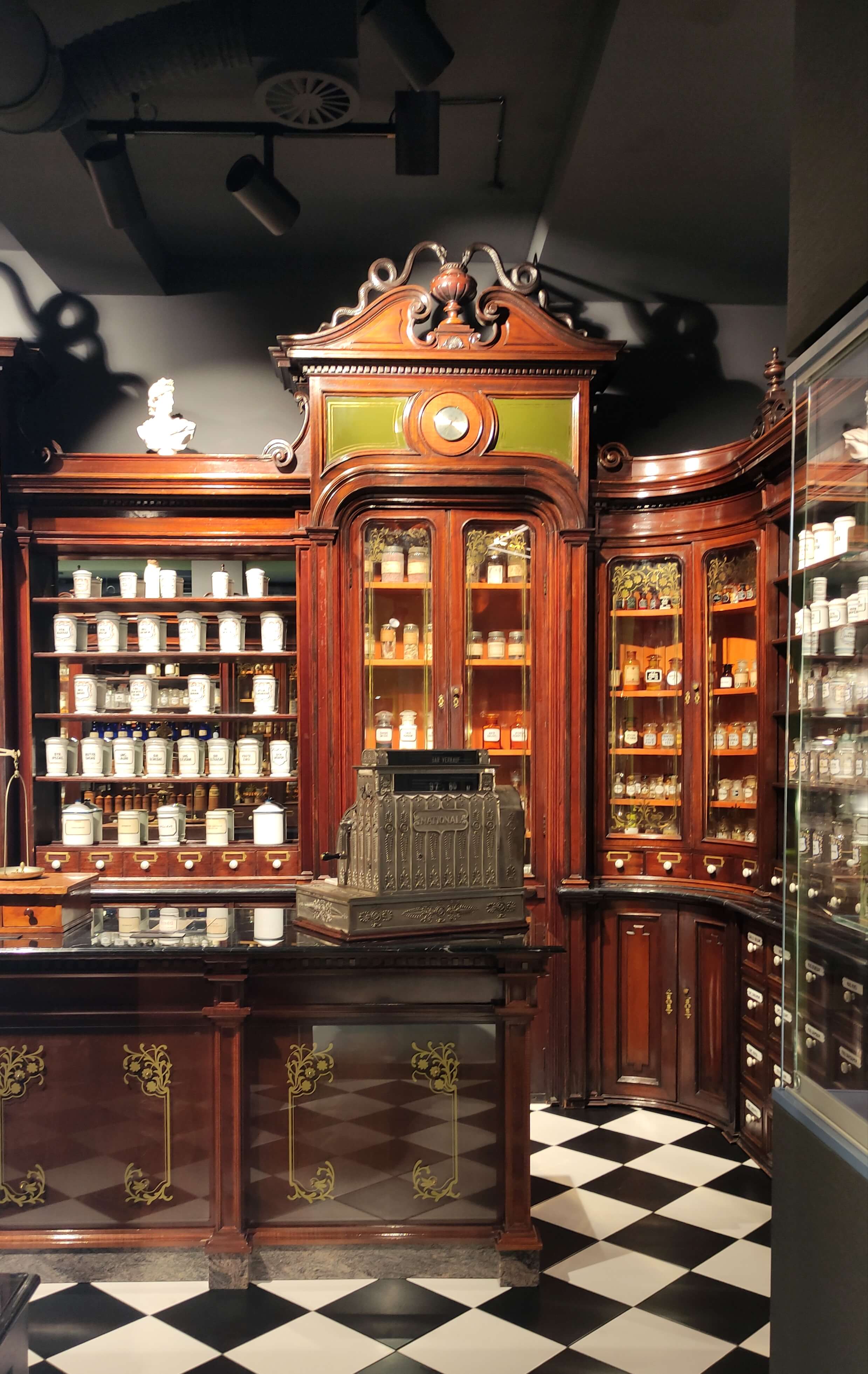
The exhibition gives us insight into local history as well, featuring two pharmaceutical companies from Rijeka, ‘Alga’ and ‘Ljekarna Jadran’. A pioneer not only in pharmaceuticals and cosmetics but in advertising as well, Alga was a marketing powerhouse and a household name in the interwar period. Their first product, named ‘Alga za masažu’ (massage algae), was made of natural extracts of native plants and was said to heal every malady from a toothache to influenza.
The ad below urges retailers to buy Alga in bulk and guarantees they’ll sell every single unit, or else they can return the unsold stock to the manufacturer:
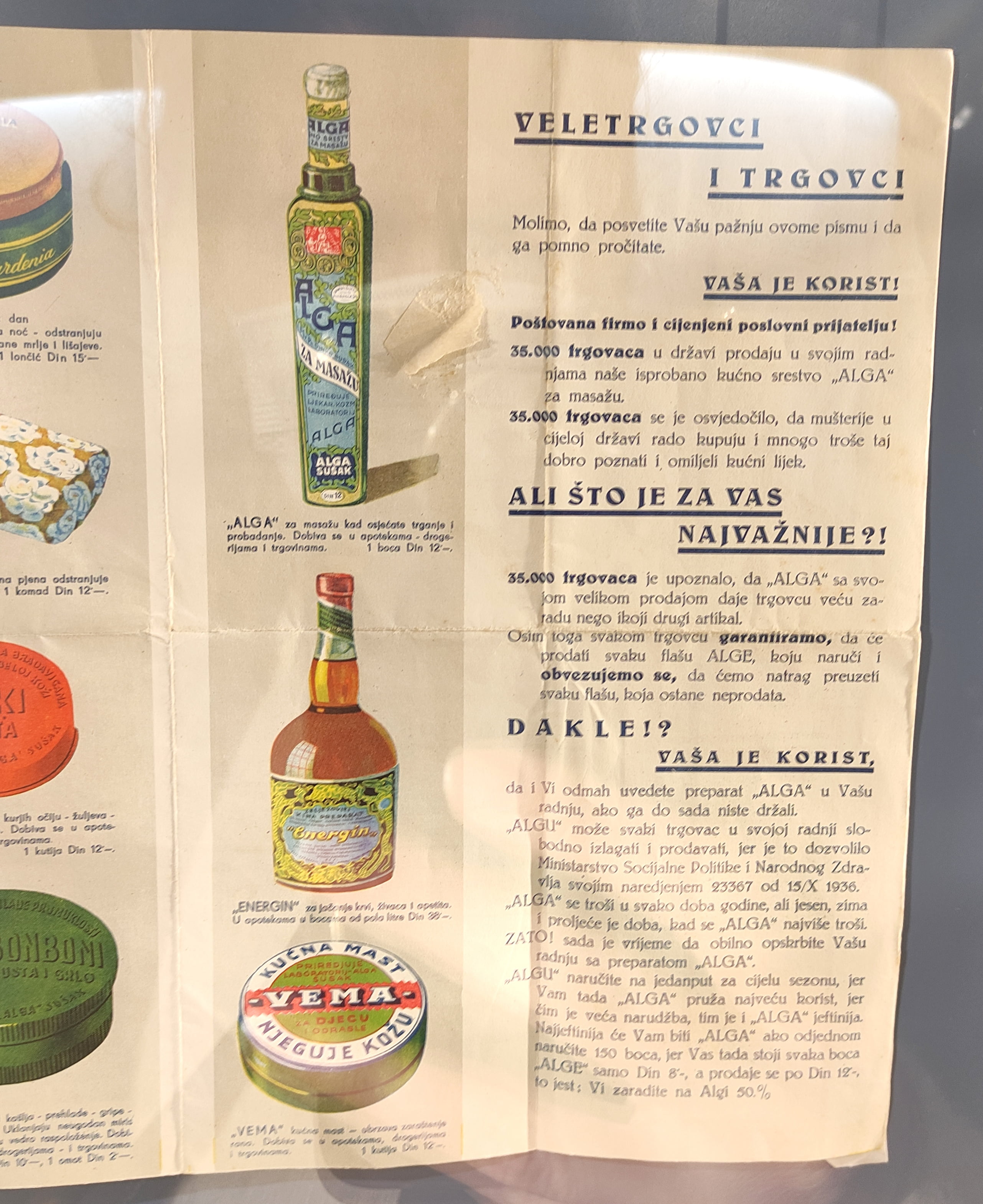
A section of the permanent exhibit is dedicated to medicinal herbs, including a modern twist on a herbarium and many cabinets and drawers to peek into:
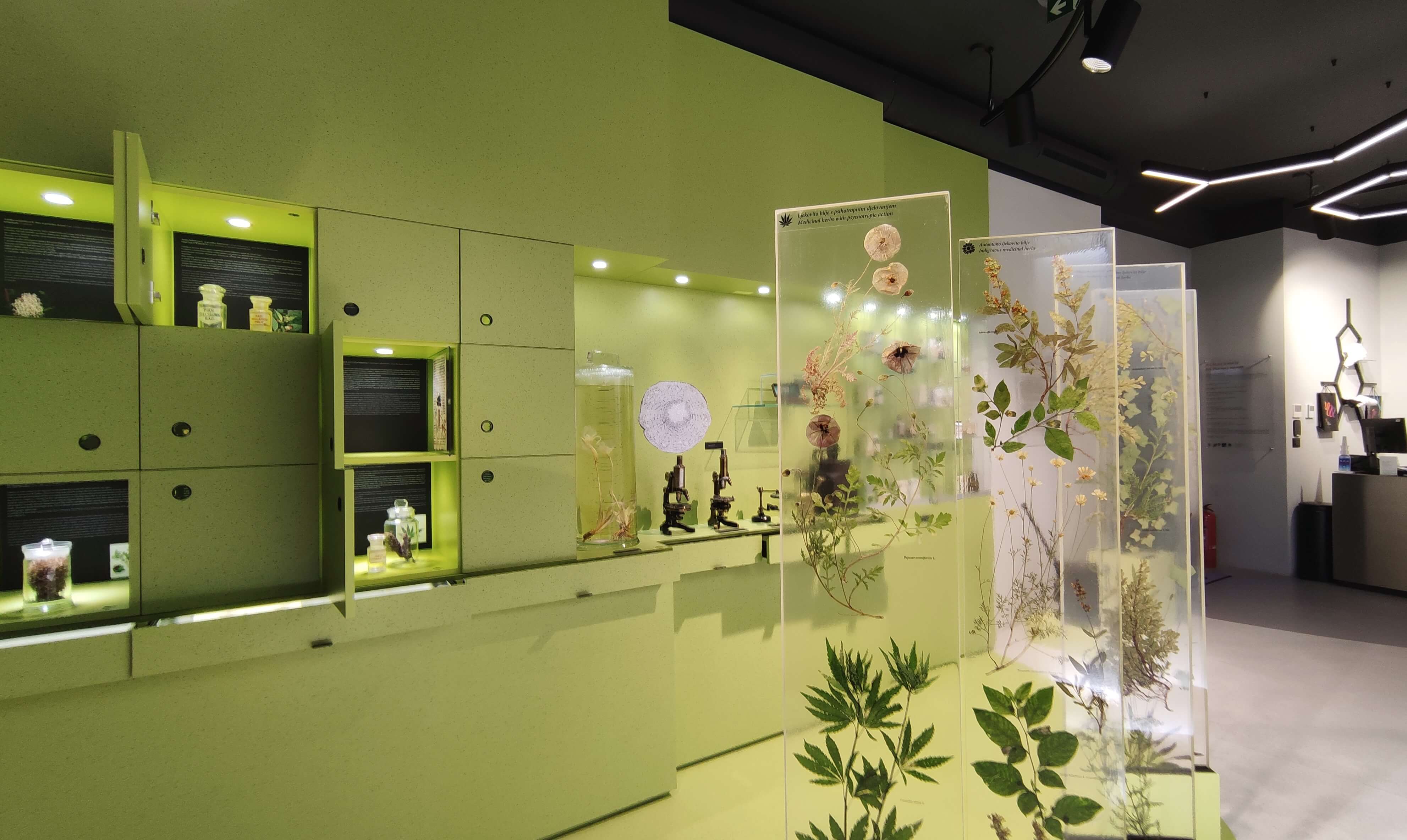
The entire display is superbly designed and allows the visitor to decide how much time and attention they want to dedicate to each exhibit; it doesn’t overwhelm with historical facts or scientific data, instead presenting information in an engaging and interactive way.
Indulge your obsession with historical curiosities and vintage bric-a-brac (just me?) and leave with a renewed appreciation for science. Overall, an excellent place to spend a Saturday afternoon.
Learn more about the JGL Pharmacy Museum on their website, and discover other attractions worth visiting in Rijeka in our guide here.
Rijeka-Belgrade Flight to Connect Krk with Several International Destinations
January 21, 2022 - The return of the Rijeka-Belgrade flight is already great news, but also because it allows travelers to connect to numerous destinations around the world.
After the announced return of Ryanair and Condor, another very important airline that operated to Rijeka in the pre-pandemic period - Air Serbia - is returning to Rijeka Airport, reports Novi List.
After cutting the direct line to Belgrade in 2020 after the pandemic, Air Serbia returns to Krk with the Rijeka-Belgrade direct flight. The first flight is expected on June 15, and flights will run until September 17, twice a week, on Wednesdays and Saturdays.
Tickets went on sale in the middle of the week, and the price of a one-way ticket is currently only 374 kuna, while the return ticket is 676 kuna. The flight lasts an hour and 20 minutes, and ATR72 aircraft will operate on this route.
Air Serbia launched flights to Rijeka in June 2019. The last flights ran in December of that year, after which they were suspended until further notice due to the coronavirus pandemic. In that year, the direct line between Rijeka and Belgrade was established after thirty years, with the proviso being year-round, so even in winter, it was possible to fly to Belgrade. After the line was canceled due to the pandemic, there was talk that it would be permanently abolished, but, fortunately, those announcements proved wrong.
"Air Serbia offers good connections from Rijeka, via Belgrade, to Amsterdam, Vienna, Zurich, Dusseldorf, Milan, New York, Oslo, Paris, Podgorica, Rome, Stockholm, and Tivat, as well as to Rijeka, via Belgrade, from Amsterdam, Berlin, Vienna, Brussels, Zurich, Frankfurt, Milan, Podgorica, Rome, Stuttgart, and Tivat," according to the Serbian national airline.
"We are happy to significantly improve and diversify our network by carefully selecting new destinations, following the wishes of passengers and strategic plans for future expansion," said Boško Rupić, sales manager at Air Serbia.
Commenting on the introduction of the new line, Irena Peršić Živadinov, director of the Kvarner Tourist Board, reminded of the importance of this market for the region and pointed out that the significance of this line is that the Serbian partner has several connecting flights.
"It is an important market for us anyway. Guests from Serbia traditionally love Kvarner and are excellent consumers. They spend when they visit, considering that the upper class visits us. Moreover, they often come for extended weekends, so in that sense, the air connection from Belgrade to Rijeka will undoubtedly make their arrival easier. Another key feature of this line is that it has a lot of connecting flights, either with Europe or with further destinations such as New York or Moscow.
Therefore, this line is important to us not only for connecting with the Serbian market but also for easier access from several other markets. So we had the Belgrade-Rijeka flight set on the days of the week when the connecting flights were in Belgrade.
We have many additional airline connections with several countries," said Peršić Živadinov, adding that partners in Air Serbia are optimistic about the new route, especially since, for example, the route from Belgrade to Pula last year proved extremely popular.
Serbian tourists were loyal to Kvarner during the pandemic. According to the Kvarner Tourist Board, there were even more overnights by Serbian tourists in Kvarner in commercial accommodation last year than in the pre-pandemic 2019. Specifically, in 2019, about 21,000 guests from Serbia arrived in Kvarner, who spent about 111,000 nights, while last year, about 20,000 Serbian tourists arrived, who spent about 114,000 nights. If those in non-commercial accommodation, i.e., in cottages, are taken into account, overnight stays are doubled. In 2019, 206 thousand overnight stays were realized in commercial and non-commercial accommodation, and last year 190 thousand overnight stays.
For more on flights to Croatia and other travel announcements, make sure to check out our dedicated travel section.
Getting Around Rijeka by Bus Just Became Easier With Google Transit Now Available in Maps
January 15, 2022 - The transit feature in Google Maps allows users to view public transportation options and keep track of departure times and stops
IT company Exevio from Rijeka helped implement the Google Transit feature in their city after a year of collaboration with Google, announced the bus company Autotrolej.
Autotrolej allowed Google access to their unified database of routes, timetables and other relevant data. After a successful collaboration of the local bus company with the tech giant, getting around Rijeka by bus will be easier than ever for locals and tourists alike.
Google Transit is a service within Google Maps that allows users to view public transportation options including detailed information about the route; it lists the next few departure times and all the stops between the starting point and the end destination. In Rijeka, for example, the user is guided to the nearest bus stop; once they board the bus, they can track the route along the way and are alerted to the destination stop.
Why enthusiastically report on a feature that’s technically a navigation standard these days? This isn’t exactly groundbreaking technology in this day and age; the Transit feature has been available in Zagreb since 2014, and is also available in Google Maps for Osijek and Pula.
However, it’s something that Rijeka has been sorely lacking until now. With the local bus network being the only available mode of public transportation in Rijeka, the way information is presented leaves a lot to be desired.
Even though the Autotrolej website provides detailed information regarding bus lines, routes and departure times, one would need to know their way around the city quite well for the said information to make sense.
It’s unlikely that first-time visitors to the city would be able to smoothly navigate the bus network based on Autotrolej maps and timetables alone, and Google Transit will certainly help tourists get around town by bus more easily. A small but important step in making the public infrastructure in Rijeka more tourist-friendly.
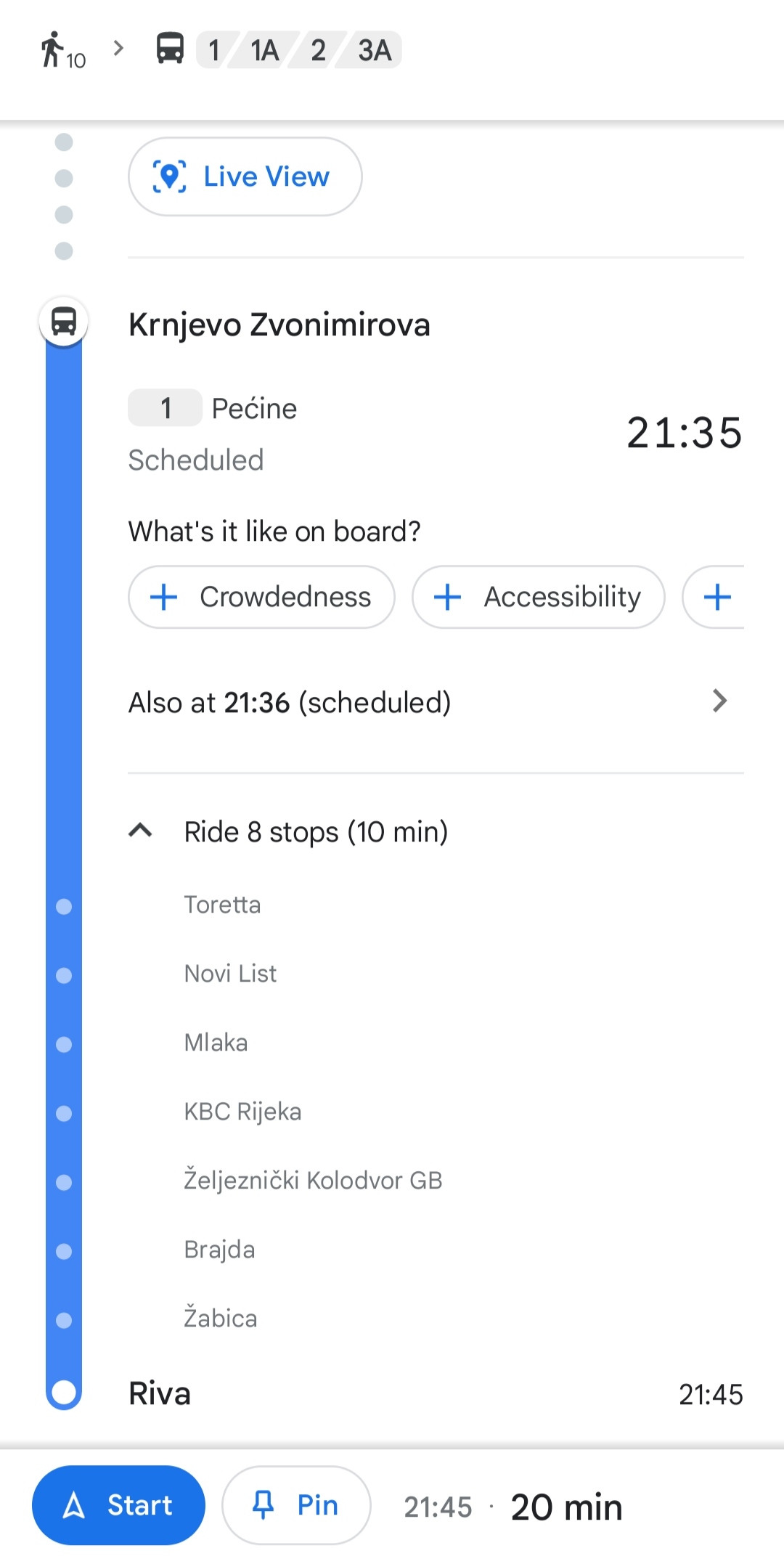
Locals are sure to embrace the new navigation service as well - this particular local is happy to attest to this. While we do have a solid grasp of all the bus routes in town, departure times and schedules have always been somewhat of an enigma.
Until now, the timetables only specified departure times for the first stop of any given line, and some of the lines operate on considerably long routes. Knowing when a bus is departing from the other side of town doesn’t mean much, especially during rush hour or in busy downtown traffic. Add to that the frequent schedule changes that are easy to overlook, and you end up missing a bus by a few minutes and having to wait for another 20 minutes quite often.
Unlike the lucky folk in Zagreb where tram stops are equipped with digital displays showing when the next trams are about to arrive, so far in Rijeka we could only resort to waiting around and hoping that a bus will eventually show up. Not anymore!
Thanks to Google Transit, departure times are now listed for every bus stop in town, and even though the information might not be 100% accurate as of yet, it’s definitely a massive help when getting around town by bus.
I put Transit to the test a few days ago to see how reliable and accurate the schedule is in Rijeka. I changed location a few times and used them as starting points, and picked a few random addresses as the end destinations just to get route suggestions and a list of estimated times of arrival.

In this example, bus no.2 was supposed to show up exactly at 12:00pm at this stop. It ended up arriving a minute early, not too bad!
The other two showed up exactly on the specified time of arrival. It’s a relief to have a bit more certainty when it comes to public transportation - it looks like the dark ages are finally behind us indeed.
While the schedules are currently based on fixed Autotrolej timetables, Google Transit in Rijeka should soon provide public transportation updates in real time as well.
Rijeka Carnival Rescheduled for Summer 2022
January 13th, 2021 - Rijeka’s biggest annual event was rescheduled for the summer due to epidemiological measures currently in effect
The city of Rijeka was just about to enter the so-called fifth season of the year - the carnival. St. Anthony’s Day on January 17th kicks off the festive season of carnival parades, costumed parties and related traditional customs such as the burning of the Pust effigy.
However, preparations came to a halt earlier today when the City of Rijeka announced that the two central events won’t be taking place in February as they usually do.
The International Carnival parade and the Children’s Carnival Parade were postponed until early summer 2022, as confirmed by Rijeka City Mayor Marko Filipović.
‘Unfortunately, due to the new strong wave of the coronavirus pandemic and the need to adhere to strict epidemiological measures, the Rijeka Carnival cannot take place in its full scope at present, which is why the central carnival events won’t take place at the time they usually do’, said Filipović.
The two parades won’t be cancelled in full this year, but have instead been rescheduled for early summer, a season in which a better epidemiological situation is expected.
‘The International Carnival Parade and the Children’s Parade are postponed until the beginning of the summer and I hope that the pandemic won’t mess with our plans again at that time. The same goes for the Charity Masked Ball, which was also rescheduled for the summer’, said Filipović.
He went on to add that some of the carnival events haven’t been rescheduled, such as the traditional ceremony that kicks off the carnival season in Rijeka: on Monday, the key to the city will be handed over to the Carnival Master.
Petar Škarpa, the director of the Rijeka Tourist Board, also commented on the City’s decision to reschedule the two grand parades.
‘Even though we all eagerly anticipate the carnival season, we’re aware that the present time is particularly challenging, that we have to be responsible and carefully consider the dangers that holding the Rijeka Carnival at this moment could cause. The epidemiological situation is dire all over the country and as long as that’s the case, the Rijeka Carnival cannot take place in the form that we’re used to. The carnival is a festival of costumes, joy, fun and gathering, and this is exactly what we need to give up temporarily, keeping in mind the health of our citizens and guests, as we hope to return to normal as quickly as possible’, said Škarpa.
The Tourist Board director also said that despite all their efforts to come up with an acceptable alternative way of holding the popular parades within the restrictions of the current epidemiological measures, it became clear that any alternative would mean forsaking the essence of the carnival - a day when people don masks to forget all their troubles and enjoy the festivities in absolute freedom.
‘We hope and believe that things will improve by summer and that we’ll be able to focus on sweeter kinds of worries, e.g. what costume to put on when it’s 25°C outside. Let’s use the months ahead to be even more creative and come up with new ideas that will further improve the quality of Rijeka’s best known tourism product’, said Škarpa.
He added that the Rijeka Carnival is proud to host carnival groups and interested visitors from all over the world each year, and expressed his hope that the new carnival dates will be seen as an opportunity by those who have always wanted to see Rijeka, but perhaps had no chance to visit the city thus far.
Small-scale events are moving forward according to schedule, such as the Carnival Days of Laughter, a programme of 4 attractive comedies to be performed at the HKD Sušak.
Stormy Winds on the Croatian Coast Tore Down Trees and Electrical Cables
January 12, 2022 - In the past two days, stormy winds on the Croatian coast on Tuesday tore down trees and electrical cables, raised the roofs of houses and overturned vehicles, and some citizens were without electricity for several hours.
HRT News reports that yesterday the County Center 112 Rijeka received several reports of disasters caused by stormy winds in the Primorje-Gorski Kotar County, according to the website of the Directorate of Civil Protection.
In the area of the municipality of Čavle, several telephone poles were broken and a tree fell on the road. In Crikvenica, in King Tomislav Street, the wind blew away part of the tin roof of the family house. A telephone pole in Selce was broken, a tree in the yard of a family house was knocked down in Dramalj, and a truck overturned on a local road in the Kraljevica area. An electric cable fell on the family house in Križišće.
In the area of Rijeka, the tree fell on a personal vehicle in Braće Stipčić Street and in the Orehovica area, and in a warehouse in the port, the wind blew away part of the tin roof. Due to broken poles on the transmission network of Tribalj, Drivenik, and Grižane in Vinodol municipality 1000 users were without electricity from 12:22 pm to 14:26 pm, and in Bribir in Vinodol municipality 200 users from 13:15 pm to 15:14 pm.
In Split-Dalmatia County, the County Center 112 Split received about 20 reports during the day about fallen trees, broken branches, traffic signs, and various objects that fell on the road and obstructed traffic. According to the reports, the competent services were informed. There were no reports of major damage.
In Dubrovnik-Neretva County, the "Dr. Franjo Tuđman" bridge was closed to all traffic due to strong winds from January 10 at 4:50 pm to January 11 at 11:00 am. It was closed again at 3:50 pm, the Civil Protection Directorate reported.
For more about the weather in Croatia, be sure to check Total Croatia's guide.
To read more about lifestyle in Croatia, follow TCN's dedicated page.


